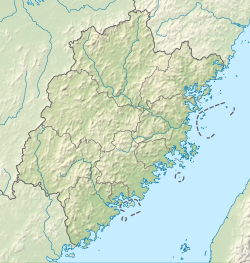
Back فوجيان تولو Arabic Fujian Tulou AST Fucyen tulouları Azerbaijani Fujian Tulou Catalan Hók-gióng tū-làu CDO Tchu-lou Czech Tulou de Fujian Spanish فوجیان تالو Persian Fujianin tulout Finnish Tulou du Fujian French
| UNESCO World Heritage Site | |||||||||||||||||||||||
|---|---|---|---|---|---|---|---|---|---|---|---|---|---|---|---|---|---|---|---|---|---|---|---|
 Tianluokeng Tulou cluster | |||||||||||||||||||||||
| Location | Fujian, China | ||||||||||||||||||||||
| Includes | |||||||||||||||||||||||
| Criteria | Cultural: (iii), (iv), (v) | ||||||||||||||||||||||
| Reference | 1113 | ||||||||||||||||||||||
| Inscription | 2008 (32nd Session) | ||||||||||||||||||||||
| Area | 152.65 ha (377.2 acres) | ||||||||||||||||||||||
| Buffer zone | 934.59 ha (2,309.4 acres) | ||||||||||||||||||||||
| Coordinates | 25°1′23″N 117°41′9″E / 25.02306°N 117.68583°E | ||||||||||||||||||||||
| Chinese name | |||||||||||||||||||||||
| Simplified Chinese | 福建土楼 | ||||||||||||||||||||||
| Traditional Chinese | 福建土樓 | ||||||||||||||||||||||
| Literal meaning | "Fujian earthen buildings" | ||||||||||||||||||||||
| |||||||||||||||||||||||

The Fujian tulou (simplified Chinese: 福建土楼; traditional Chinese: 福建土樓; pinyin: Fújiàn tǔlóu; lit. 'Fujian earthen buildings') are Chinese rural dwellings[1] unique to the Hakka in the mountainous areas in southeastern Fujian, China. They were mostly built between the 12th and the 20th centuries.[2]
A tulou is usually a large, enclosed and fortified earth building, most commonly rectangular or circular in configuration, with very thick load-bearing rammed earth walls between three and five stories high and housing up to 800 people. Smaller interior buildings are often enclosed by these huge peripheral walls which can contain halls, storehouses, wells and living areas, the whole structure resembling a small fortified city.[3]
The fortified outer structures are formed by compacting earth, mixed with stone, bamboo, wood and other readily available materials, to form walls up to 6 feet (1.8 m) thick. Branches, strips of wood and bamboo chips are often laid in the wall as additional reinforcement. The result is a well-lit, well-ventilated, windproof and earthquake-proof building that is warm in winter and cool in summer.[3] Tulous usually have only one main gate, guarded by 4–5-inch-thick (100–130 mm) wooden doors reinforced with an outer shell of iron plate. The top level of these earth buildings has gun holes for defensive purposes.
Most of the tulou (with the exception of the Dadi tulou cluster in Hua'an county) are found in a relatively small geographical area, straddling the boundary between the Yongding, Nanjing, and Pinghe counties of Fujian province. Some of tulous are also found in neighboring Guangdong province such as in eastern Dabu County of Meizhou. These are administered as a single tourist site (known as the Nanjing Tulou Scenic Area) with its entrance in Shuyang township (Nanjing County, Zhangzhou). Visits to this area therefore usually comprise a tour of the most distinctive and famous across both the "Yongding" (Gaobei Tulou cluster, Hongkeng Tulou cluster, Chuxi Tulou cluster, Zhenfulou Earthen House, and Yanxianglou Earthen House) and "Nanjing" (Tianluokeng Tulou cluster, Hekeng Tulou cluster, Heguilou Earthen House, and Huaiyuanlou Earthen House) tulou groups.
A total of 46 Fujian tulou sites were inscribed in 2008 by UNESCO as World Heritage Site, as "exceptional examples of a building tradition and function exemplifying a particular type of communal living and defensive organization [in a] harmonious relationship with their environment". The inscribed sites include Chuxi Tulou cluster, Tianluokeng Tulou cluster, Hekeng Tulou cluster, Gaobei Tulou cluster, Dadi Tulou cluster, Hongkeng Tulou cluster, Yangxian Lou, Huiyuan Lou, Zhengfu Lou, and Hegui Lou.[2]
- ^ Joseph Needham, Science and civilization in China V4 pt3. p. 133-134, 1971 Cambridge University Press
- ^ a b Fujian Tulou. UNESCO World Heritage Center
- ^ a b Earthen Houses (Tulou), Fujian Province Archived 2014-05-12 at the Wayback Machine Macau Cultural Affairs Bureau
© MMXXIII Rich X Search. We shall prevail. All rights reserved. Rich X Search

